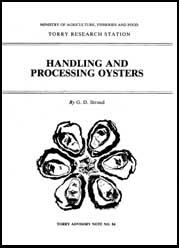Contents Index

Accompanying Notes
Table of Contents
By G. D. Stroud
MINISTRY OF AGRICULTURE, FISHERIES AND FOOD
TORRY RESEARCH STATION
TORRY ADVISORY NOTE NO. 84
Crown copyright material is reproduced with the permission of the Controller of Her Majesty's Stationery Office.
This electronic document has been scanned using optical character recognition (OCR) software and careful manual recorrection. Even if the quality of digitalisation is high, the FAO declines all responsibility for any discrepancies that may exist between the present document and its original printed version.
Describes the species of oyster marketed in the UK, and gives distinguishing features, common and scientific names, and some brief background information on production, geographical distribution, cultivation, grading for size and transport and storage of live oysters. The total amount of oysters harvested in the UK in 1998 was about 2100 tonnes, 50% of which was farmed production. The Note provides information on handling and processing, including shucking, yield and composition of meat, chilling, freezing in the shell, half shell and as shucked meat, cold storage and shelf life, and other oyster products including smoked and canned meats. Briefly considers utilisation of waste shell. Shell can be deposited at sea as culch to encourage the settlement of spat, but it is essential that any disposal at sea complies with local bye-laws and with fish health regulations. Disposal onshore must be licensed.
The risks of food poisoning are primarily from sewage contamination of harvesting areas and the unpredictable occurrence of toxin producing microalgae. As filter-feeders, oysters can accumulate pathogenic and other bacteria as well as viruses from sewage contamination, and can accumulate potent toxins from toxic microalgae present among the phytoplankton on which they feed. Illnesses such as gastro-enteritis and hepatitis can result from sewage contamination. Briefly, regulations require that bivalve molluscs for human consumption can only be obtained from the areas officially classified for harvesting. The regulations also require compliance with the expressed limits for bacteria, toxins and contaminants and producers are expected to meet the end-product standards. The category of contamination, or classification, officially assigned to the growing waters, or harvesting area, determines whether the bivalves can be marketed directly or, before marketing, must be purified, relayed in a designated area for a required period to purge them of bacteria, or subjected to an approved heat process in approved premises. It is important to note that heat processing may be needed simply to produce a cooked product from molluscs that are already safe to eat or it may be an approved treatment required to ensure that microbiologically contaminated molluscs are rendered safe to eat; different regulations cover these two situations. Briefly, the approved heat processes to inhibit the development of pathogenic microorganisms in bivalve molluscs are:
Further guidance may be found in a publication of the Sea Fish Industry Authority (1997), 'Guidelines for the Facilities and Equipment Required for Handling Bivalve Molluscs from Harvesting through to Distribution to Retail Outlets', available from the Sea Fish Industry Authority, Logie Green Road, Edinburgh, EH7 4HG, UK. Full details of cleansing procedures and approvals, and shellfish hygiene classifications of growing waters, can be obtained from CEFAS Weymouth, Barrack Road, Weymouth, Dorset, DT4 8UB, or from Fisheries Research Services, Victoria Road, Aberdeen, AB11 9DB.
Different algal toxins can cause paralytic shellfish poisoning (PSP), diarrhoetic shellfish poisoning (DSP) or amnesic shellfish poisoning (ASP). Monitoring of shellfish harvesting areas is required for the occurrence of toxic phytoplankton, shellfish flesh is monitored for the presence of toxins and producers are expected to meet end-product standards. When the toxins exceed the prescribed limits, areas are closed by voluntary agreement or by closure order, and closures are frequent.
(FAO in partnership with Support unit for International Fisheries and Aquatic Research, SIFAR, 2001).
Introduction
Species in the UK
Foreign names
UK oyster production
Geographical distribution
Cultivation
Fishing rights
Raw oysters
Grading for size
Transport and storage
of live oysters
Shucking
Carriage of chilled meats
Yield and composition of meals
Freezing oysters
Oyster products
Oyster shells
Contents Index